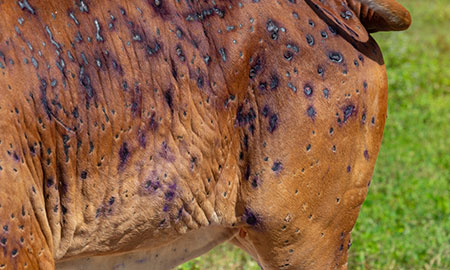Lumpy skin disease (LSD) is a viral disease of cattle and buffalo that causes relatively low mortality, however the disease can result in animal welfare issues and significant production losses.
Infection typically causes an acute disease with fever, depression, and characteristic skin nodules. There may also be a marked reduction in milk yield as well as abortion in pregnant animals.
Cattle and water buffalo infected with LSD typically show the following signs:
- Firm, raised lumps up to 50 mm in diameter can develop on any part of the body. They are often on the skin around the head, neck, genitals and limbs.
- The centre of the nodules dies, after which the resultant scabs may fall out, leaving large holes in the skin, that may become infected.
- Swelling of the limbs, brisket, genitals and lymph nodes may occur.
- Watering eyes.
- Increased nasal and salivary secretions.
- Loss of appetite and reluctance to move.
Some animals with the disease may not show clinical signs.
How LSD spreads
The disease is spread by biting flies, mosquitoes and ticks. It can also travel long distances through the movement of infected animals or through contaminated items including animal handling equipment, livestock vehicles, as well as people’s clothing and footwear. In some cases, it spreads directly from animal to animal.
The disease has shown its ability to establish and spread in a wide range of environmental and productions systems around the world.
Potential impacts of LSD in Australia
The disease not only presents animal health and welfare issues but an incursion in Australia would:
- affect our beef cattle, water buffalo and dairy industries
- impact our domestic and international trade as Australia would no longer be recognised as being free from LSD
- result in economic losses to Australia’s associated industries including meat processing, retailers and livestock transporters.
Human health and meat consumption
The LSD virus does not affect people. While meat from infected cattle is safe to eat, Australia would opt for a humane destruction approach if the disease occurred here. This would see any affected cattle or buffalo disposed of under strict biosecurity processes, and not enter our food chain.
Disease distribution
Originally limited to Africa, the global distribution of LSD is increasing. Since 2019 it has spread throughout China and Southeast Asia. In 2021 it was confirmed in Vietnam, Thailand and Malaysia. In 2022 it was officially reported by Indonesia and Singapore.
See what the government is doing to prevent an LSD incursion in Australia.

